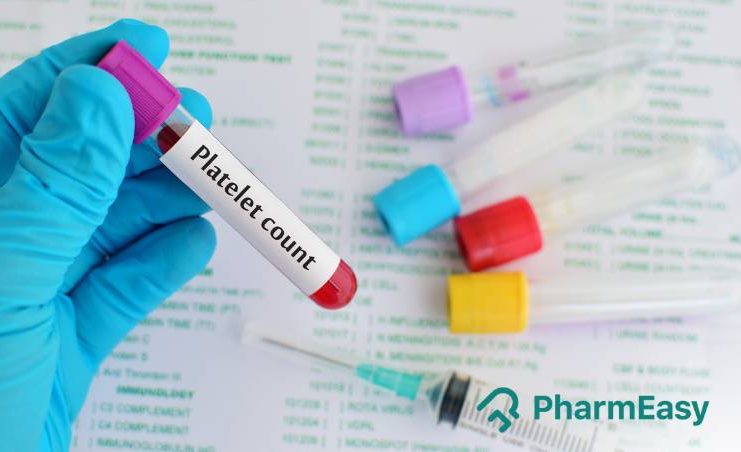Low Platelet Count – Symptoms, Causes & Treatment
By Dr. Mayuri Pandey +2 more

Get,

to manage your symptom
Get your,


4 Cr+ families
benefitted

OTP sent to 9988776655



You’ve successfully subscribed to receive
doctor-approved tips on
Whatsapp

Get ready to feel your best.

Hi There,
Download the PharmEasy App now!!


Register to Avail the Offer
Send OTPBy continuing, you agree with our Privacy Policy and Terms and Conditions

Hi There,
Sign up on PharmEasy now!!
Trusted by 4 crore+ families

OTP sent to 9988776655



You have unlocked 25% off on medicines




Code: NU25
By Dr. Mayuri Pandey +2 more
Table of Contents
Blood cells known as platelets help stop bleeding by the formation of blood clots. In adults, an ordinary platelet count or level is between 150,000 and 450,000 platelets per microliter of blood. However, sometimes these levels might differ and get reduced due to certain conditions.
Insufficient platelet count known as thrombocytopenia, causes easy bruising and bleeding tendencies. It lead to lack of blood clot formation making it difficult for the bleeding to stop after an injury1. In this blog, we will discuss about low platelet counts in detail- their causes, presentation and management.

One of the initial signs, when they do occur, is a cut that will not stop bleeding. Additional signs include2,3:
Symptoms of low platelet count2:
Some patients with moderately low platelet count do not exhibit any symptoms. They may also report nonspecific symptoms like easy bruising, skin rashes and bleeding from gums and other areas of mouth1,2.
There are three primary causes of reduced platelets:
Insufficient platelets are produced in the bone marrow
If you suffer from either of the following kinds of disorders, your bone marrow might not produce enough platelets.
In aplastic anaemia, the bone marrow fails to produce enough blood cells. This might be due to1:
In the case of myelodysplastic syndrome, the bone marrow either produces insufficient or faulty blood cells. This might be due to1:
The factors that contribute to a low platelet count are crucial for identifying individuals who may be at risk4:
Diagnostic methods for low platelet count:
Healthcare providers can often improve platelet counts by addressing the underlying cause, which may involve changes in medication. Additional treatment options may include:
Also Read: How To Increase Platelet Count Naturally
It is important for your doctor to know if you have any medical conditions or take medications that increase your risk of developing thrombocytopenia. If you are not sure, consult your doctor to find out if there are any prescription drugs or activities you should avoid.
Severe low platelet count can make patients more prone to1,8:
Thrombocytopenia symptoms can develop suddenly or over the years. It might also cause bleeding in more than one part of your body. Seek immediate medical help if1:
Low platelet count, or thrombocytopenia, can arise from various causes ranging from infections and medications to chronic health conditions. Therefore, recognising symptoms such as easy bruising, prolonged bleeding, or unexplained fatigue is crucial for timely diagnosis.
With proper medical evaluation and treatment, whether through lifestyle changes, medications, or targeted therapies, most cases can be effectively managed. Keep in mind that early detection and appropriate care play a key role in preventing complications and ensuring better health outcomes.
Complete Blood Count test, blood clotting time test, and peripheral blood cells test1.
Based on the root cause of low platelet count, doctors help improve the count of platelets1.
Low platelet count is also called thrombocytopenia2.
In a healthy, normal person, the platelet count is between 150 and 450 thousand per microliter of blood1.
Mild, moderate, and severe are the three levels of thrombocytopenia1.
1. Jinna S, Khandhar PB. Thrombocytopenia. [Internet]. StatPearls Publishing; [cited 2025 Sep 16]. Available from: https://www.ncbi.nlm.nih.gov/books/NBK542208/
2. National Heart, Lung, and Blood Institute. Platelet Disorders – Thrombocytopenia [Internet]. NHLBI, NIH; [cited 2025 Sep 16]. Available from: https://www.nhlbi.nih.gov/health/thrombocytopenia
3. Wilson ID. Hematemesis, Melena, and Hematochezia. In: Walker HK, Hall WD, Hurst JW, editors. Clinical Methods: The History, Physical, and Laboratory Examinations. 3rd ed. Boston: Butterworths; 1990. Chapter 85. Available from: https://www.ncbi.nlm.nih.gov/books/NBK411/
4. National Heart, Lung, and Blood Institute. Platelet Disorders – Causes and Risk Factors [Internet]. NHLBI, NIH; [cited 2025 Sep 16]. Available from: https://www.nhlbi.nih.gov/health/platelet-disorders/causes
5. Mangla A, Hamad H. Thrombocytopenia in Pregnancy [Internet]. StatPearls Publishing; [cited 2025 Sep 16]. Available from: https://www.ncbi.nlm.nih.gov/books/NBK547705/
6. Hernáez Á, Lassale C, Castro-Barquero S, Ros E, Tresserra-Rimbau A, Castañer O, et al. Mediterranean Diet Maintained Platelet Count within a Healthy Range and Decreased Thrombocytopenia-Related Mortality Risk: A Randomized Controlled Trial. Nutrients. 2021 Feb 8;13(2):559. Available from: https://pubmed.ncbi.nlm.nih.gov/33567733/
7. Izak M, Bussel JB. Management of thrombocytopenia. F1000Prime Rep. 2014 Jun 2;6:45. Available from: https://pmc.ncbi.nlm.nih.gov/articles/PMC4047949/
8. Ashworth I, Thielemans L, Chevassut T. Thrombocytopenia: the good, the bad and the ugly. Clin Med (Lond). 2022 May;22(3):214-217. Available from: https://pmc.ncbi.nlm.nih.gov/articles/PMC9135082/
Disclaimer: The information provided here is for educational/awareness purposes only and is not intended to be a substitute for medical treatment by a healthcare professional and should not be relied upon to diagnose or treat any medical condition. The reader should consult a registered medical practitioner to determine the appropriateness of the information and before consuming any medication. PharmEasy does not provide any guarantee or warranty (express or implied) regarding the accuracy, adequacy, completeness, legality, reliability or usefulness of the information; and disclaims any liability arising thereof.
Links and product recommendations in the information provided here are advertisements of third-party products available on the website. PharmEasy does not make any representation of the accuracy or suitability of such products/services. Advertisements do not influence the editorial decisions or content. The information in this blog is subject to change without notice. The authors and administrators reserve the right to modify, add, or remove content without notification. It is your responsibility to review this disclaimer regularly for any changes.
Comments

Leave your comment...
You may also like
Comments